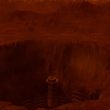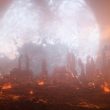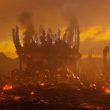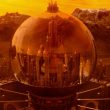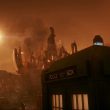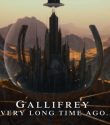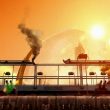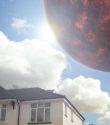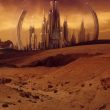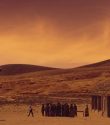

Name:
Gallifrey
Also Called:
Jewel
the Shining World of the Seven Systems
the Homeworld
Winkle’s Wonderland
Gallifrey Original
Legoland
Type:
Planet
Location:
Kasterborous
Seven Systems
Moons:
Pazithi Gallifreya
Natives:
Gallifreyans
Killer Cats
flutterwings
Interstitial
Woprats
trunkikes
Beatitude
Time Sentinel
yaddlefish
Pig-rat,
Gargantosaur
The Pariah
flubbles
tafelshrews
TARDIS
rovies
CyberMasters
Shobogans
First Mentioned In:
An Unearthly Child
First Seen In:
The War Games
Appearances:
Doctor Who
Season 6
The War Games
Season 8
Colony in Space
Season 10
The Three Doctors
Season 14
The Deadly Assassin
Season 15
The Invasion of Time
Season 18
Full Circle
Season 20
Arc of Infinity
20th anniversary special
The Five Doctors
TV Movie
The TV Movie
Home Video
The Five Doctors Special Edition
Series 3
The Sound of Drums
Series 4
The End of Time
Series 7
The Name of the Doctor
Prequels
The Last Day
2013 specials
The Day of the Doctor
Series 8
Listen
Series 9
Heaven Sent/Hell Bent
Series 12
Spyfall
Ascension of the Cybermen/The Timeless Children
Comics
TV Action
The Spoilers
TV Comic
Return of the Daleks
Doctor Who Magazine
The Stolen TARDIS
The Tides of Time
The Stockbridge Horror
Time & Time Again
The Final Chapter
Winter Specials
Flashback
Doctor Who Yearbook
Blood Invocation
BBC Writers’ Comics
Destiny’s Door
Titan Comics
Doctor Who: The Eleventh Doctor
The Scream
Mini-series and one-shots
Supremacy of the Cybermen
Novels Edit
Target novelisations
Doctor Who and the Doomsday Weapon
The Three Doctors
Doctor Who and the Deadly Assassin
Doctor Who and the War Games
Doctor Who and the Invasion of Time
Arc of Infinity
The Five Doctors
Virgin New Adventures
Cat’s Cradle: Time’s Crucible
Nightshade
Blood Harvest
Lungbarrow
Virgin Missing Adventures
Goth Opera
A Device of Death
Cold Fusion
BBC Eighth Doctor Adventures
The Eight Doctors
Legacy of the Daleks
The Shadows of Avalon
The Ancestor Cell
BBC Past Doctor Adventures
The Infinity Doctors
Warmonger
World Game
BBC New Series Adventures
Engines of War
Virgin Bernice Summerfield New Adventures
Dead Romance
Faction Paradox
The Book of the War
Short stories
Brief Encounter
Affirmative
Short Trips
The Longest Story in the World
Jealous, Possessive
The Exiles
The Time Lord’s Story
The Three Paths
Doctor Who Annual
Blind Fury
Snow White and the Seven Keys to Doomsday
Heroes and Monsters
The Stranger
Time Lord Fairy Tales
The Twins in the Wood
The Gallifrey Chronicles
The Scrolls of Rassilon
Doctor Who website
Doctor Who and the Time War
Myths & Legends
Pandoric’s Box
Now We Are Six Hundred
The Five Doctors
The Red and the Blue
Audio
Main Range
The Sirens of Time
The Apocalypse Element
Zagreus
Time in office
Specials
The Five Companions
Second Sight
Eighth Doctor Adventures
Series 2
Sisters of the Flame
The Vengeance of Morbius
Dark Eyes
Dark Eyes I
The Great War
Fugitives
Tangled Web
X of the Daleks
Doom Coaltion
Doom Coalition 1
The Eleven
The Satanic Mill
Doom Coalition 3
The Crucible of Souls
Doom Coalition 4
Songs of Love
The Side of the Angels
Stop the Clock
The War Doctor
Only the Monstrous
The Innocent
Casualties of War
The Enigma Dimension
The Companion Chronicles
Series 8
The Beginning
Novel Adaptations
Cold Fusion
Gallifrey
Series 1
Weapon of Choice
Square One
The Inquiry
A Blind Eye
Series 2
Lies
Spirit
Pandora
Insurgency
Imperiatrix
Series 3
Fractures
Warfare
Appropriation
Mindbomb
Panacea
Series 4
Reborn
Disassembled
Annihilation
Forever
Series 5
Emancipation
Evolution
Arbitration
Series 6
Extermination
Renaissance
Ascension
Series 7
Intervention Earth
Series 8
Enemy Lines
Time War: Volume One
Celestial Intervention
Soldier Obscura
The Devil You Know
Desperate Measures
Time War: Volume Two
Havoc
Partisans
Collateral
Assassins
The Legacy of Time
Collision Course
Short Trips
The Wings of a Butterfly
The Toy
Erasure
The True History of Faction Paradox
Words from Nine Divinities
Ozymandias
The Judgment of Sutekh
Webcast
BBCi
Shada

click on images to enlarge

Gallifrey was the homeworld of the Time Lords. (The Time Warrior) By one account, the planet was actually called Jewel, (Return of the Daleks) and during several time wars, it was utilitarianly referred to as the Homeworld. (Damaged Goods, The Book of the War, etc) It was also called Gallifrey Original. (Doctor Who and the Time War) The literal translation of the name “Gallifrey” was “They that walk in the shadows”. (The Pit)
Gallifrey and all its cloneworlds were destroyed in the War in Heaven. (The Ancestor Cell, The Adventuress of Henrietta Street) It was destroyed in the Last Great Time War when the Eighth Doctor used the Moment to engulf it and seal the event inside a time lock. (Doctor Who and the Time War) According to another account, it was only believed to have been destroyed in the Last Great Time War (The End of the World) but was actually frozen in a pocket universe by the first thirteen incarnations of the Doctor (The Day of the Doctor, The Time of the Doctor) and later discovered at the end of the universe. (Hell Bent) By this point in their history, the Time Lords were wary of being discovered alive, although they still continued their mission to ensure nothing threatened the Laws of Time. (Lords and Masters)
The Master was later revealed to have been responsible for leaving Gallifrey in ruins after finding out the truth about the Timeless Child. (Spyfall) After The Master used the corpses of the Time Lords he’d killed to create a new race of CyberMasters, Ko Sharmus detonated the death particle to stop him, wiping out all organic life on Gallifrey. (The Timeless
LOCATION
Gallifrey was located in the constellation of Kasterborous at galactic coordinates 10-0-11-0-0/0-2 from Galactic Zero Centre. (Pyramids of Mars, Full Circle, Death in Heaven) Several accounts placed it more or less at the centre of its galaxy. (The Devil Goblins from Neptune, Interference – Book Two, Human Nature) Indeed, I.M. Foreman once specified to the Eighth Doctor that it wasn’t in “the exact dead centre, but it’s as close as you can get without ending up in a black hole”. (Interference – Book One) According to another account, the Eighth Doctor explained to humans Grace Holloway and Chang Lee that Gallifrey was “[o]n the other side of your galaxy” and “250 million light-years away” from Earth. (The TV Movie) Another put Gallifrey 30, 000 light-years from Earth. (The Devil Goblins from Neptune) It was described as “the Shining World of the Seven Systems”. (The Sound of Drums)
Besides its physical location, the Homeworld also occupied a unique place in the structure of history: during the anchoring of the thread, it was removed from the Spiral Politic and re-engineered into a biodata-enabled receiver and processorof information. (The Book of the War)
Shortly before the War in Heaven, Greyjan the Sane’s plan for creating clones of Gallifrey was implemented. (The Ancestor Cell) By the fiftieth year of the War, it was unclear if the original Homeworld was still located in its original place or if it had been moved elsewhere and replaced with a decoy; (The Book of the War) not even the Lord President knew which Gallifrey was the original. (The Taking of Planet 5) All of the Gallifreys were destroyed by the end of the War. (The Adventuress of Henrietta Street)
Near the end of the Last Great Time War, Gallifrey was removed from the time lock and relocated near to Earth with potentially devastating consequences for the latter planet. The Tenth Doctor returned it to the time lock by shooting and destroying the diamond which connected Gallifrey to Earth. (The End of Time) At the end of the Time War, it was frozen in time in a pocket universe for its own protection by “all thirteen” incarnations of the Doctor. (The Day of the Doctor)
Missy later told The Doctor that Gallifrey had returned to its original position. The Doctor travelled to these coordinates and found only empty space, believing Missy to have lied. (Death in Heaven) The truth was, Gallifrey had in fact returned to the universe as Missy said. However, it had been placed at the extreme end of the time continuum for protection. The General described Gallifrey’s location as “the end of the universe, give or take a star system.” (Hell Bent)
ASTRONOMICAL DATA
WORLDLINE
Gallifrey itself was protected by a complex temporal defence, its worldline twisted and warped through all eleven dimensions to hide it from Enemy attack. (The Quantum Archangel)
SIZE
Gallifrey was several times larger than Earth. (The End of Time) According to another account, however, Gallifrey was the same size as Earth. (Dead Romance)
STAR SYSTEM
Gallifrey was in a binary star system. The second star seemed to rise in the south in the morning, making the mountains glow. (Gridlock) The main star was large and golden red. (The Forever Trap) The system contained five other planets (The Invasion of Time), among them Karn (The Brain of Morbius) and Polarfrey, and an asteroid named Kasterborous the Fibster. (Lungbarrow) The Sixth Doctor claimed that Gallifrey was “just to the left” of Karn. (Vortex Ice)
SATELITES
Gallifrey had at least two large moons and a ring system, similar to Saturn in Earth’s solar system. (Agent Provocateur) One of the moons was the copper-coloured Pazithi Gallifreya, which shone so brightly it could be seen during the day. (Cat’s Cradle: Time’s Crucible, Lungbarrow) Gallifrey’s moons perished with The Daleks when Gallifrey disappeared. (Agent Provocateur, The Day of the Doctor)
LANDSCAPE
From orbit, the planet’s surface appeared mostly barren, with only a few visible buildings. (Return of the Daleks) Its landscape was rust-coloured, with brown lakes and grey clouds. (Cat’s Cradle: Time’s Crucible) Following the Last Great Time War, it was still rust and brown coloured but had a more volcanically-active appearance. (The End of Time)
Susan Foreman once described it as “a brown, green, snow-capped planet.” (The Beginning)
From the planet’s surface, it boasted an orange sky at night, (“A Desperate Venture”) snow-capped slopes of red grass, (Gridlock) and trees with bright silver leaves. (“A Desperate Venture”, Gridlock) These reflected the morning sunlight, making it look like the forests were on fire. (Gridlock) There were also green forests, golden fields, and red deserts, (Cat’s Cradle: Time’s Crucible) but overall it was a much drier world than Earth. (Lungbarrow) The Sixth Doctor once declared the climate to be “like the Serengeti all year round”. (Spiral Scratch) There was also a river called Lethe. (Master) The wastelands around the Capitol were referred to as “outer Gallifrey” by the Time Lords. (The Invasion of Time) Rassilon later referred to the area that the barn in which The Doctor had slept as a child as the Drylands, claiming that no one of importance lived there. (Hell Bent)
Most of the mountainous southern hemisphere had a fierce and wintry landscape. (The Scarlet Empress)
The sky during the day resembled that of Earth’s blue sky. (The Invasion of Time) As such, the shift from night to day (and vice versa) appeared to be half orange and half blue. (The Day of the Doctor)
KNOWN GEOGRAPHIC FEATURES
REGIONS OF GALLIFREY
The Citadel was located on the continent of Wild Endeavour. (The Sound of Drums)
The Drylands were on Gallifrey, typically the area where, according to Rassilon, “nobody who mattered” lived. (Hell Bent)
The Death Zone was an area used as a battleground in which Time Lords would watch other species fight to the death. Although these battles were stopped by Rassilon, the Death Zone remained and later became home to the Tomb of Rassilon. (The Five Doctors)
Arcadia was Gallifrey’s second city. (The Day of the Doctor)
The black, friable spires of Yarvelling’s Church from Skaro were a fragment of the Last Great Time War. According to one account, the Eighth Doctor saw the Cathedral fused with fragments of Morbius’ Red Capitol in the backwater where he triggered the Moment. (Doctor Who and the Time War)
There was also a mountainous region known as South Gallifrey, (State of Decay) which was outside the territory of the Great Houses. (The Return of the King)
Killer Cats lived in Gin-Seng. (Erasure, The Last Fairy Tale)
MOUNTAINS
Mount Cadon (Timewyrm: Revelation, Lucifer Rising, The Three Paths) was also known as Mount Lung (Lungbarrow, The Three Paths) and Mount Plutarch. (The Three Paths)
The Citadel of the Time Lords was located in the mountains of Solace and Solitude. (The Sound of Drums)
Other mountains on Gallifrey included Mount Perdition (The End of Time) and the Mountain of Serenity. (The Stranger)
The Myridian mountains separated the Arcadian desert from the lowlands of Outer Gallifrey. (Mistfall)
RIVERS, LAKES AND OCEANS
There were at least two known rivers and one lake: Cadonflood River, (Lungbarrow) the Lethe river, (Master) and Lake Abydos. (Neverland) Less than half of Gallifrey’s surface was covered with water. (Coldheart)
HISTORY
In preparation for war, Gallifrey was duplicated in the Nine Gallifreys project. (The Shadows of Avalon) The enemy destroyed the original Gallifrey during the War in Heaven, though the Time Lords continued fighting from the other Gallifreys. (Alien Bodies) One Gallifrey was destroyed by the Eighth Doctor. (The Ancestor Cell)
On the final day of the Time War, the Time Lords, led by Rassilon, broke the time lock to materialise Gallifrey in Earth’s skies in 2009, thinking the War Doctor would precipitate their ultimate demise on that final day through the Moment. However, the Tenth Doctor sent the planet, Time Lords included, back to its doomed fate, by breaking the link that brought the Time Lords to Earth. (The End of Time)
While one account showed Gallifrey being destroyed by the Eighth Doctor when he used the Moment to end the Time War, (Doctor Who and the Time War) and one source claimed that millions of Time Lords indeed died in an instant when The Doctor ended the Time War, driving the Matrix to madness in the process, (Sky Jacks) several other accounts indicated that Gallifrey and its inhabitants had not actually been destroyed, but rather frozen in time in a pocket dimension, “like a painting” as the War Doctor put it, by the first thirteen incarnations of the Doctor. (The Day of the Doctor) However another account suggested that hundreds of incarnations of the Doctor past and future saved the planet. (The Day of the Doctor) The vast majority of the Daleks died in the crossfire when Gallifrey disappeared, (The Day of the Doctor) with most of the survivors running away in terror to parts unknown at the sight of this sudden and incomprehensible victory by their greatest enemy. (The Day of the Doctor)
The Eleventh Doctor would subsequently spend 900 years (Tales of Trenzalore: The Eleventh Doctor’s Last Stand) defending a crack in time linking Gallifrey with the planet Trenzalore. (The Time of the Doctor) The Twelfth Doctor unsuccessfully attempted to find the planet after Missy told him untruthfully that it had returned to its original position in time and space, (Death in Heaven) and finally spent 4.5 billion years (Hell Bent) trapped inside a confession dial, gradually beating his way through a wall of solid azbantium, until he finally broke through, revealing a portal back to Gallifrey. (Heaven Sent) The Doctor learned that at some point, Gallifrey was unfrozen and moved to “the end of the universe give or take a star system” for its own protection. Clara Oswald suggested that the Time Lords moved Gallifrey there to hide as “everybody” hated them. After returning, The Doctoroverthrew Rassilon and used an extraction chamber to save Clara’s life before fleeing once more in a stolen TARDIS. (Hell Bent)
At some point, The Master returned to Gallifrey wile it was hiding inside a bubble universe and learned that its entire history had been”built on a lie”. Enraged, he ravaged the planet and left it in ruin. Upon encountering the Thirteenth Doctor, The Master persuaded her to visit the planet again to observe the destruction. (Spyfall) Its ruins later appeared at the Boundary, where The Master met the Thirteenth Doctor once again, promising that “everything [was] about to change”. (Ascension of the Cybermen) The Doctor returned to Gallifrey with The Master who used the Matrix to reveal the truth about the Timeless Child and Gallifrey’s history to The Doctor. The Master invited Ashad and his army of Cybermen to the planet and attempted to create an army of CyberMasters out of the Time Lord corpses. However, the Cybermen were defeated by The Doctor and her companions while Ko Sharmus detonated the death particle to stop The Master, wiping out all organic life on Gallifrey, The Master and CyberMasters presumably included. (The Timeless Children)
At the very end of time itself, part of the Cloisters were preserved in a reality bubble sustained by Me so she could watch the end of everything. The Twelfth Doctor visited there with talk to Me about the Hybrid. After the discussion, the two left in the TARDIS he had acquired, after which the reality bubble gave out and the universe finally ended. (Hell Bent)
SETTLEMENTS
A major city on Gallifrey was known as the Citadel (The Invasion of Time, The Sound of Drums) or sometimes, the Capitol. (The Deadly Assassin)
Dronid and Karn were colonies of Gallifrey. (Shada, Alien Bodies, Cat’s Cradle: Time’s Crucible)
Arcadia, Gallifrey’s “second city”, was protected by a large number of sky trenches. These defences failed on the last day of the Time War, and the city was ravaged by The Daleks. The War Doctor was present at the Fall of Arcadia, and it was there that he left his warning of “No More” for the combatants. (The Day of the Doctor)
Two other cities, called Olyesti and Slothe, also existed. (The Infinity Doctors, Blind Fury)
NATIVE SPECIES
FLORA
Gallifrey had a wide variety of plant life, ranging in colour from silver to green and golden. Known plant species included the Schlenk Blossom, (Island of Death) ulanda, (Blind Fury) and the Madevinia aridosa. (Cat’s Cradle: Time’s Crucible) The Master’s father’s estate was lush with red grass. (The End of Time) The Third Doctor also once said that there were daisies on Gallifrey. (The Time Monster) Weanskrike and Tristort grew on Mount Lung. (The Three Paths) There was also a red flower that resembled a cross between a rose and a daisy, known to Gallifreyans as a Sarlain. (Timewyrm: Revelation) The Flowerof Remembrance was a six-petalled yellow flower, (The Infinity Doctors, The Ancestor Cell) and one of the few symbols of death on the planet. (Dead Time, The Ancestor Cell) Another flower grown on Gallifrey was a moonlight bloom, which, according to the Eighth Doctor, was symbolic for peace and meditation, until it became a symbol of cowardice among Time Lord soldiers during the Time War. (The Conscript) There were trees on Gallifrey which bear large, yellow, edible fruit. (The Twins in the Wood)
FAUNA
Animals native to Gallifrey included flutterwings, (The Pirate Planet) flies, (Heaven Sent) Woprats (Heart of TARDIS) broakirs, trunkikes, yaddlefish, (Blind Fury) flubbles, (Island of Death) tafelshrews, (Cat’s Cradle: Time’s Crucible) plungbolls, (The Ghosts of N-Space) rabbits, (Caerdroia) rovies, (No Place Like Home) mice, cats, (The Mark of the Rani, Human Nature) the Killer Cats of Gin-Seng, (Erasure, The Return of the King) pig-rats, (Panacea) cobblemice, (Unnatural History, The Gallifrey Chronicles) and, of course, the Gallifreyans themselves. Dogs with black-and-white striped fur and which made mewing noises were found in forests on Gallifrey. (The Twins in the Wood)
In the past, the dinosaur-like Gargantosaurs lived on the planet. (The Stolen TARDIS) According to one account, no animal had gone extinct from the planet. (The Last Dodo) However, according to another account, a large lizard-like creature that had been placed out of its time in the Death Zone was described by the War Doctor as “a long-extinct species from before the Time Lords ever walked the planet”. (Engines of War)
BEHIND THE SCENES
RELATED LINKS
Back to Alien Planets page



